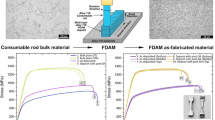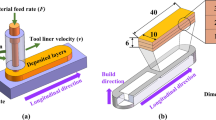Abstract
Friction-based additive manufacturing processes that allow the free design of the deposition path are expected to be used for the rapid production of large-scale high-performance aluminum alloy components. This study successfully fabricated multilayer deposits for 6061 aluminum alloy by friction extrusion additive manufacturing (FEAM) at a high deposition rate. The interfacial bonding properties and material utilization of the final deposits prepared at different rotational speeds were thoroughly investigated and evaluated based on the microstructural observations and mechanical test results. The multilayer deposition process was more stable and reliable at 400 rpm, and each layer was constant in width and thickness, approximately 32 mm wide and 4 mm thick. Planar interfaces were produced regardless of rotation speed, except that metal flow was more intense near the interface at 400 r/min in the driving friction zone, resulting in better interface formation and material utilization of 62.5%. The recrystallization fraction in the extrusion zone (EZ) of the fresh deposit at 400 r/min is 8.9% higher, and the deformation and recrystallization textures predominated in this region. After multiple thermal cycles and plastic deformation, dynamic recovery and subsequent static recovery occurred in the EZ, accompanied by subgrain coarsening and grain growth. Tensile properties in the build direction at 400 r/min are superior to those at 600 r/min, with tensile strength, 0.2% proof stress, and elongation after fracture being 47.4%, 32.0%, and 103% of the extruded 6061-T651 aluminum alloy, respectively.











Similar content being viewed by others
Data availability
The raw/processed data required to reproduce these findings cannot be shared at this time as the data also forms part of an ongoing study.
References
Boyer RR (1996) An overview on the use of titanium in the aerospace industry. Mater Sci Eng A 213:103–114. https://doi.org/10.1016/0921-5093(96)10233-1
Williams JC, Starke EA Jr (2003) Progress in structural materials for aerospace systems. Acta Mater 51:5775–5799. https://doi.org/10.1016/j.actamat.2003.08.023
Shimizu S, Fujii HT, Sato YS, Kokawa H, Sriraman MR, Babu SS (2014) Mechanism of weld formation during very-high-power ultrasonic additive manufacturing of Al alloy 6061. Acta Mater 74:234–243. https://doi.org/10.1016/j.actamat.2014.04.043
Uddin SZ, Murr LE, Terrazas CA, Morton P, Roberson DA, Wicker RB (2018) Processing and characterization of crack-free aluminum 6061 using high-temperature heating in laser powder bed fusion additive manufacturing. Addit Manuf 22:405–415. https://doi.org/10.1016/j.addma.2018.05.047
Martin JH, Yahata BD, Hundley JM, Mayer JA, Schaedler TA, Pollock TM (2017) 3D printing of high-strength aluminium alloys. Nature 549:365–369. https://doi.org/10.1038/nature23894
Sridharan N, Gussev M, Seibert R, Parish C, Norfolk M, Terrani K, Babu SS (2016) Rationalization of anisotropic mechanical properties of Al-6061 fabricated using ultrasonic additive manufacturing. Acta Mater 117:228–237. https://doi.org/10.1016/j.actamat.2016.06.048
Utyaganova VR, Filippov AV, Shamarin NN, Vorontsov AV, Savchenko NL, Fortuna SV, Gurianov DA, Chumaevskii AV, Rubtsov VE, Tarasov SY (2020) Controlling the porosity using exponential decay heat input regimes during electron beam wire-feed additive manufacturing of Al-Mg alloy. Int J Adv Manuf Technol 108:2823–2838. https://doi.org/10.1007/s00170-020-05539-9
Yu HZ, Jones ME, Brady GW, Griffiths RJ, Garcia D, Rauch HA, Cox CD, Hardwick N (2018) Non-beam-based metal additive manufacturing enabled by additive friction stir deposition. Scr Mater 153:122–130. https://doi.org/10.1016/j.scriptamat.2018.03.025
Gussev MN, Sridharan N, Thompson Z, Terrani KA, Babu SS (2018) Influence of hot isostatic pressing on the performance of aluminum alloy fabricated by ultrasonic additive manufacturing. Scr Mater 145:33–36. https://doi.org/10.1016/j.scriptamat.2017.10.004
Palanivel S, Nelaturu P, Glass B, Mishra RS (2015) Friction stir additive manufacturing for high structural performance through microstructural control in an Mg based WE43 alloy. Mater Des 65:934–952. https://doi.org/10.1016/j.matdes.2014.09.082
Zhao Z, Yang X, Li S, Li D (2019) Interfacial bonding features of friction stir additive manufactured build for 2195–T8 aluminum-lithium alloy. J Manuf Process 38:396–410. https://doi.org/10.1016/j.jmapro.2019.01.042
Roodgari MR, Jamaati R, Jamshidi Aval H (2020) Fabrication of a 2-layer laminated steel composite by friction stir additive manufacturing. J Manuf Process 51:110–121. https://doi.org/10.1016/j.jmapro.2020.01.031
Calvert JR (2015) Microstructure and mechanical properties of WE43 alloy produced via additive friction stir technology[D]. Virginia Tech
Blindheim J, Grong Ø, Aakenes UR, Welo T, Steinert M (2018) Hybrid metal extrusion & bonding (HYB) - a new technology for solid-state additive manufacturing of aluminium components. Procedia Manuf 26:782–789. https://doi.org/10.1016/j.promfg.2018.07.092
Xie R, Shi Y, Liu H, Chen S (2021) A novel friction and rolling based solid-state additive manufacturing method: microstructure and mechanical properties evaluation. Mater Today Commun 29:103005. https://doi.org/10.1016/j.mtcomm.2021.103005
Tang W, Yang X, Tian C, Xu Y (2022) Microstructural heterogeneity and bonding strength of planar interface formed in additive manufacturing of Al–Mg–Si alloy based on friction and extrusion. Int J Miner Metall Mater 29:1755–1769. https://doi.org/10.1007/s12613-022-2506-4
Tang W, Yang X, Tian C, Gu C (2022) Effect of rotation speed on microstructure and mechanical anisotropy of Al-5083 alloy builds fabricated by friction extrusion additive manufacturing. Mater Sci Eng A 860:144237. https://doi.org/10.1016/j.msea.2022.144237
Chaudhary B, Jain NK, Murugesan J, Patel V (2022) Exploring temperature-controlled friction stir powder additive manufacturing process for multi-layer deposition of aluminum alloys. J Mater Res Technol 20:260–268. https://doi.org/10.1016/j.jmrt.2022.07.049
Chen H, Chen J, Meng X, Xie Y, Huang Y, Xu S, Zhao Y (2022) Wire-based friction stir additive manufacturing toward field repairing. Weld J 101:249–252. https://doi.org/10.29391/2022.101.019
Martin LP, Luccitti A, Walluk M (2022) Repair of aluminum 6061 plate by additive friction stir deposition. Int J Adv Manuf Technol 118:759–773. https://doi.org/10.1007/s00170-021-07953-z
Rivera OG, Allison PG, Brewer LN, Rodriguez OL, Jordon JB, Liu T, Whittington WR, Martens RL, McClelland Z, Mason CJT, Garcia L, Su JQ, Hardwick N (2018) Influence of texture and grain refinement on the mechanical behavior of AA2219 fabricated by high shear solid state material deposition. Mater Sci Eng A 724:547–558. https://doi.org/10.1016/j.msea.2018.03.088
Priedeman JL, Phillips BJ, Lopez JJ, Tucker Roper BE, Hornbuckle BC, Darling KA, Jordon JB, Allison PG, Thompson GB (2020) Microstructure development in additive friction stir-deposited Cu. Metals (Basel) 10:1538. https://doi.org/10.3390/met10111538
Garcia D, Hartley WD, Rauch HA, Griffiths RJ, Wang R, Kong ZJ, Zhu Y, Yu HZ (2020) In situ investigation into temperature evolution and heat generation during additive friction stir deposition: a comparative study of Cu and Al-Mg-Si. Addit Manuf 34:101386. https://doi.org/10.1016/j.addma.2020.101386
Rivera OG, Allison PG, Jordon JB, Rodriguez OL, Brewer LN, McClelland Z, Whittington WR, Francis D, Su J, Martens RL, Hardwick N (2017) Microstructures and mechanical behavior of Inconel 625 fabricated by solid-state additive manufacturing. Mater Sci Eng A 694:1–9. https://doi.org/10.1016/j.msea.2017.03.105
Agrawal P, Haridas RS, Yadav S, Thapliyal S, Gaddam S, Verma R, Mishra RS (2021) Processing-structure-property correlation in additive friction stir deposited Ti-6Al-4V alloy from recycled metal chips. Addit Manuf 47:102259. https://doi.org/10.1016/j.addma.2021.102259
Rutherford BA, Avery DZ, Phillips BJ, Rao HM, Doherty KJ, Allison PG, Brewer LN, Brian Jordon J (2020) Effect of thermomechanical processing on fatigue behavior in solid-state additive manufacturing of Al-Mg-Si alloy. Metals (Basel) 10:1–17. https://doi.org/10.3390/met10070947
Phillips BJ, Avery DZ, Liu T, Rodriguez OL, Mason CJT, Jordon JB, Brewer LN, Allison PG (2019) Microstructure-deformation relationship of additive friction stir-deposition Al–Mg–Si. Materialia 7:100387. https://doi.org/10.1016/j.mtla.2019.100387
Perry MEJ, Griffiths RJ, Garcia D, Sietins JM, Zhu Y, Yu HZ (2020) Morphological and microstructural investigation of the non-planar interface formed in solid-state metal additive manufacturing by additive friction stir deposition. Addit Manuf 35:101293. https://doi.org/10.1016/j.addma.2020.101293
Julien SE, Nourian-Avval A, Liang W, Schwartz T, Ozdemir OC, Müftü S (2022) Bulk fracture anisotropy in cold-sprayed Al 6061 deposits. Eng Fract Mech 263:108301. https://doi.org/10.1016/j.engfracmech.2022.108301
Sitdikov O, Sakai T, Avtokratova E, Kaibyshev R, Tsuzaki K, Watanabe Y (2008) Microstructure behavior of Al-Mg-Sc alloy processed by ECAP at elevated temperature. Acta Mater. https://doi.org/10.1016/j.actamat.2007.10.029
EN ISO 6892–1:2019 - Metallic materials - tensile testing - part 1: method of test at room temperature (ISO 6892–1:2019). https://www.iso.org/obp/ui/#iso:std:iso:6892:-1:ed-3:v1:en. Accessed 21 2019
Abdollahzadeh A, Bagheri B, Abassi M, Kokabi AH, Moghaddam AO (2021) Comparison of the weldability of AA6061-T6 joint under different friction stir welding conditions. J Mater Eng Perform 30:1110–1127. https://doi.org/10.1007/s11665-020-05379-4
Vidakis N, Petousis M, Mountakis N, Kechagias JD (2022) Optimization of friction stir welding for various tool pin geometries : the weldability of polyamide 6 plates made of material extrusion additive manufacturing. Int J Adv Manuf Technol 2931–2955 https://doi.org/10.1007/s00170-022-10675-5
Bagheri B, Abbasi M, Dadaei M (2020) Mechanical behavior and microstructure of AA6061-T6 joints made by friction stir vibration welding. J Mater Eng Perform 29:1165–1175. https://doi.org/10.1007/s11665-020-04639-7
Agrawal P, Haridas RS, Agrawal P, Mishra RS (2022) Deformation based additive manufacturing of a metastable high entropy alloy via additive friction stir deposition. Addit Manuf 60:103282. https://doi.org/10.1016/j.addma.2022.103282
Agrawal P, Haridas RS, Yadav S, Thapliyal S, Dhal A, Mishra RS (2023) Additive friction stir deposition of SS316: effect of process parameter on microstructure evolution. Mater Charact 195:112470. https://doi.org/10.1016/j.matchar.2022.112470
Engler O, Hirsch J (2002) Texture control by thermomechanical processing of AA6xxx Al-Mg-Si sheet alloys for automotive applications - a review. Mater Sci Eng A 336:249–262. https://doi.org/10.1016/S0921-5093(01)01968-2
Wu PD, MacEwen SR, Lloyd DJ, Neale KW (2004) Effect of cube texture on sheet metal formability. Mater Sci Eng A 364:182–187. https://doi.org/10.1016/j.msea.2003.08.020
Tangen S, Sjølstad K, Furu T, Nes E (2010) Effect of concurrent precipitation on recrystallization and evolution of the P-texture component in a commercial Al-Mn alloy. Metall Mater Trans A Phys Metall Mater Sci 41:2970–2983. https://doi.org/10.1007/s11661-010-0265-8
Gandra J, Krohn H, Miranda RM, Vilac P, Quintino L, Santos JF (2014) Friction surfacing — a review. J Mater Process Technol 214:1062–1093. https://doi.org/10.1016/j.jmatprotec.2013.12.008
Liu W, Huang S, Du S, Gao T, Zhang Z, Chen X, Huang L (2022) The Effects of heat treatment on microstructure and mechanical properties of selective laser melting 6061 aluminum alloy. Micromachines 13:1059. https://doi.org/10.3390/mi13071059
Murr LE, Gaytan SM, Ramirez DA, Martinez E, Hernandez J, Amato KN, Shindo PW, Medina FR, Wicker RB (2012) Metal fabrication by additive manufacturing using laser and electron beam melting technologies. J Mater Sci Technol 28:1–14. https://doi.org/10.1016/S1005-0302(12)60016-4
Panchenko O, Kurushkin D, Mushnikov I, Khismatullin A, Popovich A (2020) A high-performance WAAM process for Al–Mg–Mn using controlled short-circuiting metal transfer at increased wire feed rate and increased travel speed. Mater Des 195:109040. https://doi.org/10.1016/j.matdes.2020.109040
Chaudhary B, Jain NK, Murugesan J, Sathiaraj D (2023) Study of microstructure evolution and mechanical properties in friction stir based additive multi-layer manufacturing of Al 6061 alloy: effect of feedstock material form and heat treatment. Mater Today Commun 34:105156. https://doi.org/10.1016/j.mtcomm.2022.105156
Griffiths RJ, Garcia D, Song J, Vasudevan VK, Steiner MA, Cai W, Yu HZ (2021) Solid-state additive manufacturing of aluminum and copper using additive friction stir deposition: process-microstructure linkages. Materialia 15:100967. https://doi.org/10.1016/j.mtla.2020.100967
Rollett A, Humphreys F, Rohrer GS, Hatherly M (2004) Recrystallization and related annealing phenomena, 2nd edn. Elsevier
Funding
This work was supported by the [National Natural Science Foundation of China] under [Grant numbers 52175356 and 51775371], [Tianjin Natural Science Foundation] under [Grant number 19JCZDJC39200], and [Tianjin Research Innovation Project for Postgraduate Students] under [Grant number 2021YJSO2B03].
Author information
Authors and Affiliations
Corresponding author
Ethics declarations
Ethics approval
Not applicable.
Consent to participate
Not applicable.
Consent for publication
All authors have read and agreed to the published version of the paper.
Conflict of interest
The authors declare no competing interests.
Additional information
Publisher's note
Springer Nature remains neutral with regard to jurisdictional claims in published maps and institutional affiliations.
Rights and permissions
Springer Nature or its licensor (e.g. a society or other partner) holds exclusive rights to this article under a publishing agreement with the author(s) or other rightsholder(s); author self-archiving of the accepted manuscript version of this article is solely governed by the terms of such publishing agreement and applicable law.
About this article
Cite this article
Tang, W., Yang, X. & Tian, C. Influence of rotation speed on interfacial bonding mechanism and mechanical performance of aluminum 6061 fabricated by multilayer friction-based additive manufacturing. Int J Adv Manuf Technol 126, 4119–4133 (2023). https://doi.org/10.1007/s00170-023-11378-1
Received:
Accepted:
Published:
Issue Date:
DOI: https://doi.org/10.1007/s00170-023-11378-1




